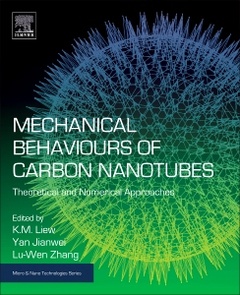Mechanical Behaviors of Carbon Nanotubes Theoretical and Numerical Approaches Micro and Nano Technologies Series
Auteurs : Liew K.M., Jianwei Yan, Zhang Lu-Wen

Mechanical Behaviors of Carbon Nanotubes: Theoretical and Numerical Approaches presents various theoretical and numerical studies on mechanical behaviors of carbon nanotubes. The main theoretical aspects included in the book contain classical molecular dynamics simulation, atomistic-continuum theory, atomic finite element method, continuum plate, nonlocal continuum plate, and shell models.
Detailed coverage is also given to structural and elastic properties, trace of large deformation, buckling and post-buckling behaviors, fracture, vibration characteristics, wave propagation, and the most promising engineering applications.
This book not only illustrates the theoretical and numerical methods for analyzing the mechanical behavior of carbon nanotubes, but also contains computational results from experiments that have already taken place.
1. Introduction2. Experimental Aspect3. Classical Molecular Dynamics Simulations4. Atomistic-Continuum Theory5. Atomic Finite Element Method and Coupling With Atomistic-Continuum Method6. Continuum Models7. Nonlocal Elasticity Theories8. Technologically Relevant Applications9. 2-D Graphene and White Graphene10. Arrangements of Carbon-Based Structures
Materials scientists, engineers, physicists and chemists
Jian-Wei Yan is a Lecturer in Solid Mechanics at the Key Laboratory of Product Packaging and Logistics of Guangdong Higher Education Institutes, Jinan University, China. His research focuses on the mechanical behaviors of nanostructures, and on computation mechanics, and he has published 11 papers in peer-reviewed journals.
Lu-Wen Zhang is a Distinguished Research Professor in Mechanics at Shanghai Jiao Tong University. Previously she was an Associate Professor at Shanghai Ocean University, China. Her main research interests focus on the computational mechanics, nanocomposite materials and smart structures. She works on her research in the areas of theoretical development and application of numerical and computational methods for applied mathematics and nanomechanics. She has published over 65 peer-reviewed journal articles, and is Editor of Journal of Modeling in Mechanics & Materials (De Gruyter). She was also Guest Editor on a Special Issue of Mathematical Problems in Engineering Journal (Hindawi Publishing) on Computational Methods for Engineering Science in 2014.
- Covers various theoretical and numerical studies, giving readers a greater understanding of the mechanical behavior of carbon nanotubes
- Includes multiscale methods that provide the advantages of atomistic and continuum approaches, helping readers solve complex, large-system engineering problems
- Allows engineers to create more efficient carbon nanotube structures and devices
Date de parution : 01-2017
Ouvrage de 462 p.
19x23.3 cm
Thème de Mechanical Behaviors of Carbon Nanotubes :
Mots-clés :
Atomic finite element method; Atomistic-continuum theory; Biotechnology; Brenner potential; Buckling; Carbon nanoring; Carbon nanotubes; Clean energy devices; Coatings; Composite materials; Conveying fluid; Coupling simulation; Cylindrical shell model; Donnell's shell model; Driving water molecules; Energy storage; Field effect transistors; Films; Fracture; Free longitudinal vibration; Free torsional vibration; Free transverse vibration; Free vibration; Global buckling; Graphene; High-quality; Highly-efficient performance; Hydrogen storage; Impurities; Local buckling; Mass detection; Mass production; Mechanical properties; Microelectronics; Molecular dynamics; Nanocones; Nanospring; Nonlocal beam; Nonlocal rod; Nonlocal shell; Polymer nanocomposites; Postbuckling; Prebuckling; Preparation method; Reactive empirical bond order potential; Reconstructions; Sensors; Testing method; Theoretical analysis; Thermal stability; Van der Waals interaction; Young's moduli



